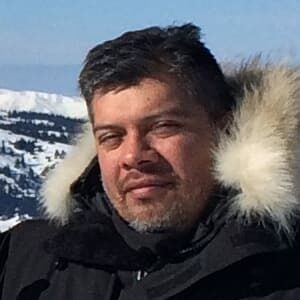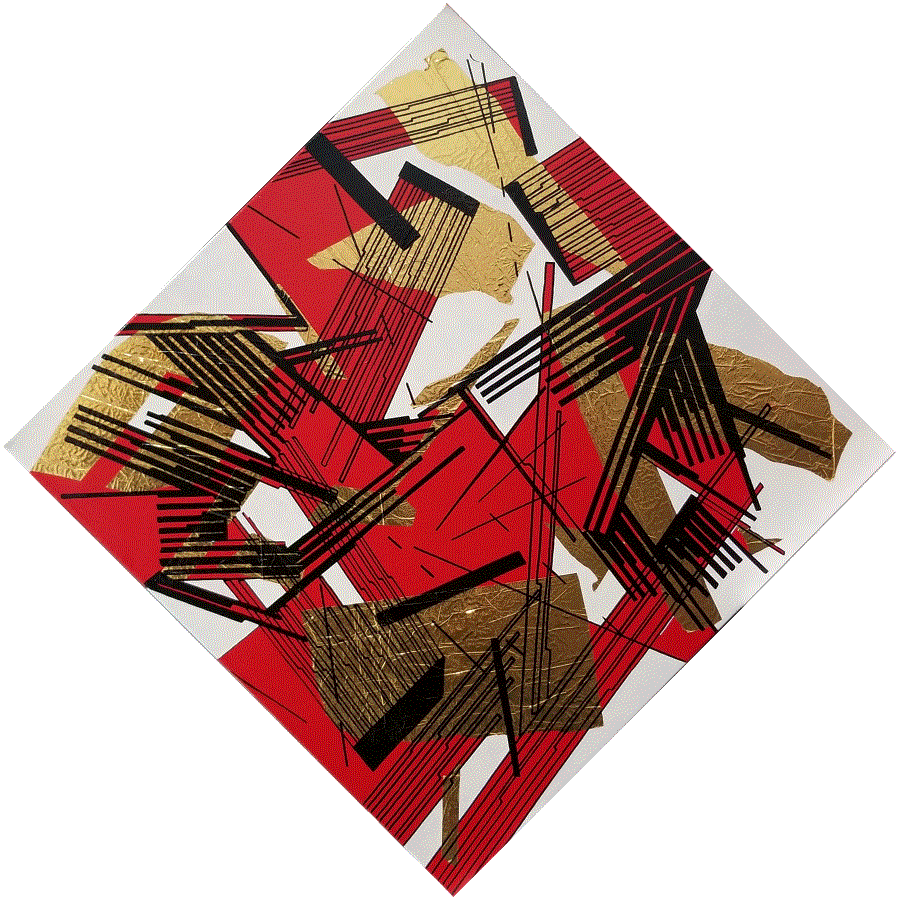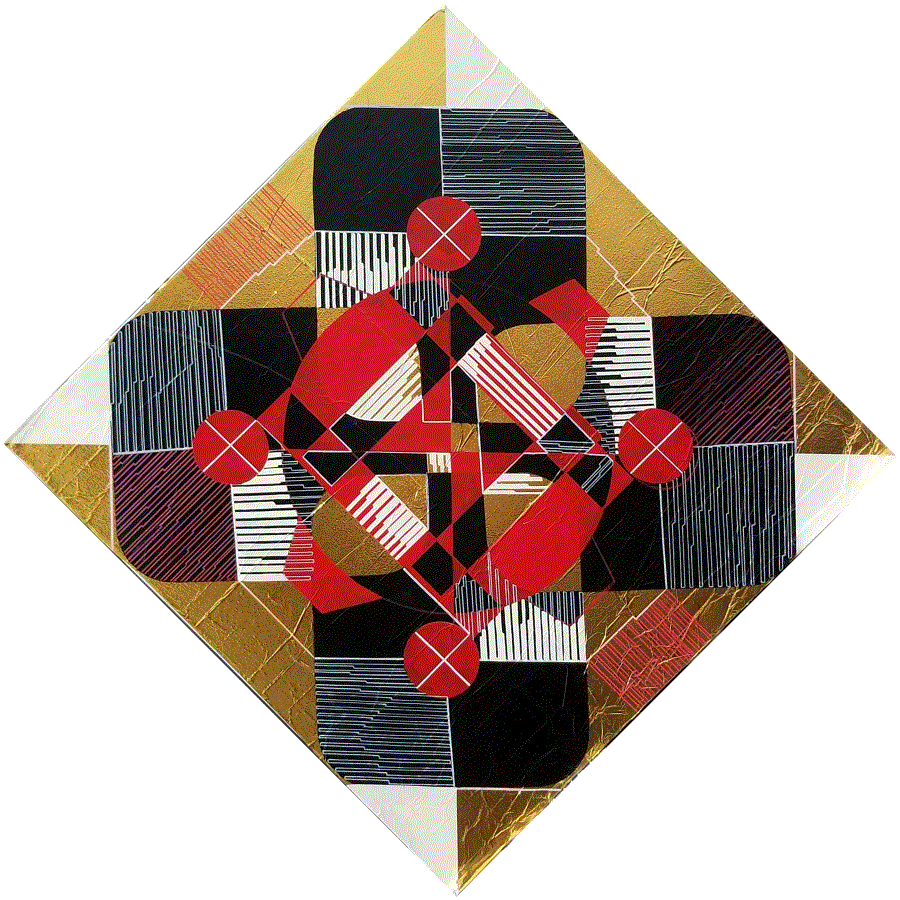
“Transforming data from very factual scientific imagery into something that is hand-rendered occurs very organically and automatically. I admire the amount of scientific research and exploration, required to produce these images that I can do anything with. I can interpret them, reinterpret them and analyze them. I don’t employ a whole lot of technology, I believe in the hand-made, the craft, and basically enjoy the actual physicality of applying pigment to a surface. I don’t look for instant ratification… rather I like the meditative aspect of taking something very complex such as imagery from advanced visualization technologies and transforming it into a formal image. The daily activity of painting is a very meditative, relaxing, and stress-free activity for me.”
Vargas – Suarez Universal
Mexico – United States—
El Dorado: Diamond VIII
Oil on vaccumized aluminum thermal blanket
24 x 24 in
2010
$ 5,000
About Vargas - Suarez Universal
Rafael Vargas-Suarez, who signs his artworks, “Vargas-Suarez Universal”, is a Mexican-born artist living in New York and working internationally. He was born in Mexico City and raised in the Houston, Texas suburb of Clear Lake City, adjacent to the Johnson Space Center (NASA). From 1991 to 1996 he studied astronomy and art history at the University of Texas at Austin and moved to New York City in 1997. He is primarily known for large-scale murals, paintings, drawings, and sound recordings. He sources American, Russian, European, Canadian and Japanese spaceflight programs, astronomy, and aerospace architecture to create commissioned, studio-based and public artworks for museums, galleries, private and public spaces. Vargas-Suarez has conducted post-studio research at NASA Ames Research Center, Mountain View, CA; Arecibo Observatory, Puerto Rico, Kennedy Space Center, Cape Canaveral, FL; Johnson Space Center, Houston, TX; Gagarin Cosmonaut Training Center, Korolyov (Moscow), Russia; and the Baikonur Cosmodrome in Kazakhstan. His writings have been published by Right Brain Words, New York; Edizioni Charta, Milano and The MIT Press, Cambridge, MA.
Selected collections include: The Museum of Modern Art Library, Whitney Museum of American Art, El Museo del Barrio, Queens Museum of Art, Brooklyn Museum of Art, Dieu Donne Papermill, Inc. Archives (all in New York); Jersey City Museum, NJ; Rhode Island School of Design Museum of Art, RI; Baltimore Museum of Art, MD; Mexic-Arte Museum, Austin,TX; Palazzo delle Papesse Centro Arte Contemporanea, Siena, Italy; Centro Atlantico de Arte Moderno (CAAM), Las Palmas de Gran Canaria, Spain; DA2 (Domus Artium, 2002) Salamanca, Spain; Museo de Arte Contemporáneo de Castilla y León (MUSAC), León, Spain, Winzavod Contemporary Art Centre, Moscow, Russian Federation, and the UBS Art Collection.
Click below to download full CV

Reviews
Carla Stellweg
New York City, April 7, 2014
“… In this prolonged discussion, we often digress into VSU’s stream of fascinating updates regarding scientific and technology-based discoveries, from the nearby or faraway. In VSU´s hands, the faraway becomes an amalgam of beyond-earth occurrences that the instruments used in space missions and the ISS’s video transmissions offer as conclusive visual data that can be translated into paintings, drawings, murals, sound, and video art pieces. VSU does not attempt to represent the universe in his visualizations of our multifarious outer space activities; instead, he abstracts the imagery of an uncanny infinite with its many secrets, those that are transmitted via complex technological and optical instruments back to our planet. There is no detail of the ‘why’ and ‘what’ in outer space that escapes his attention. Incidentally, this is also why he added ‘Universal’ to his birthname: universal is his identity as an artist, rather than his passport or political beliefs and cultural background.
Recently I texted VSU a random idea: “…The space around things, between things, under things has always played an important role. Space is a breathing room but not empty, 3 since air space is invisibly full of atoms, water vapor, microbes, electric charge, photons, magnetism, radiation, sound…Even the perfect black vacuum of space between the stars, the largest feature of our existence, is not empty; it’s teeming with waves emitted by all the things…” To which he replied, “what movie are you in now?” As we extrapolated from those ideas, we talked of other artists whose work focuses on science and technology. Trevor Paglen came up, and we discussed the similarities and differences between VSU’s and his work, which mines telescopic and other optical scientific materials. However, Paglen’s purpose in using scientific materials is to gather secret military and government activities, whereas VSU’s focus is on scientific discoveries that lead to knowledge, which in turn may provide answers to the future of life on Earth and elsewhere …”
Click below to continue reading

Deborah Cullen
October 10, 2013–June 2014
A site-specific wall drawing for Miller Theatre at Columbia University in collaboration with The Wallach Art Gallery
Raphael Vargas-Suarez (b. 1972, Mexico City; lives and works in Brooklyn), more commonly known as Vargas-Suarez Universal, is an internationally recognized artist primarily known for large-scale, site-specific wall drawings, paintings, and sound pieces. In Vector Composition No. 1, 2013, the artist transforms the architectural space of the lobby of Miller Theatre at Columbia University into his canvas. The artist’s deep interest in music is much evidenced in his work and practice, yet this project is the first time Vargas-Suarez Universal has explored this passion directly: creating a large scale wall drawing that references musical notation and staff paper through abstract geometrics.
Vargas-Suarez was raised in the Houston suburb of Clear Lake City, adjacent to the Johnson Space Center (NASA). He studied astronomy and art history at the University of Texas at Austin from 1991 to 1996, and moved to New York City in 1997. The artist’s work is based in research conducted on American and Russian manned and unmanned spaceflight programs, astronomy, and aerospace architecture. The work is informed by engineering guides for American and Russian spacecraft design; technical reports for launch preparations, manned spaceflight, and space junk mitigation; vintage NASA publications; images from spacewalk helmet cameras; hand-held digital photography by astronauts and cosmonauts; launch pad cameras; satellite photography; VR modeling; earth observation video; live NASA TV and Roscosmos TV broadcast screen shots. Often, linear “vector” drawings connect images and information while referencing the design and mathematical elements of these subjects.
Since childhood Vargas-Suarez has an abiding interest in music. His grandfather, Miguel Suarez Sanchez, had been a successful jazz musician in Mexico from the 1920s to the 1950s. Rafael grew up listening to recordings of his grandfather’s work on 78 RPM records. While Rafael played the drums, his brother played the viola and later the guitar. The family also had keyboards; in the 1980s this led to his interest in electronic and industrial music. The aesthetics associated with this type of music dovetailed with Rafael’s burgeoning interests in contemporary American and German art of that time.
Music continues to hold a special place for the artist. He has created audio works, at times in collaboration with sound artists, including a recent collaboration with the composer Stephen Barber. He conceives of these sonic landscapes as drawings with interruptions in air pressure or sound. Moreover, his very practice is closely linked to his experience of music. He paces his creative efforts to it, working in spurts related to the length of whatever album or live concert recording he chooses to accompany him.
Vargas-Suarez Universal’s work is in numerous international public and private collections including the Whitney Museum of American Art, El Museo del Barrio, Queens Museum of Art, Brooklyn Museum of Art, (all New York); Baltimore Museum of Art, MD; Mexic-Arte Museum, Austin,TX; Palazzo delle Papesse Centro Arte Contemporanea, Siena, Italy; and Winzavod Contemporary Art Centre, Moscow, Russian Federation.
The artist is currently creating murals for the new IS/PS 342 Riverside Center School, on West End Avenue between 60th and 61st Street. This work has been commissioned by the “Public Art for Public Schools (PAPS)” program, a unit of the NYC Department of Education and a program of the New York City School Construction Authority, in collaboration with the Percent for Art program of the NYC Department of Cultural Affairs. The school’s completion and inauguration is scheduled for September 2015.
Vector Composition No. 1, 2013 is a site-specific wall drawing for Miller Theatre at Columbia University presented in collaboration with The Miriam and Ira D. Wallach Art Gallery. The transformation of the theatre’s lobby marks the first collaborative project between Columbia University’s two major artistic presenting spaces.
Miller Theatre is located north of the Columbia University’s main campus gate at 116th St. and Broadway on the ground floor of Dodge Hall.
The theatre lobby is open to the public Monday through Friday, from 10 a.m. to 6 p.m., and beginning two hours before each scheduled performance.




